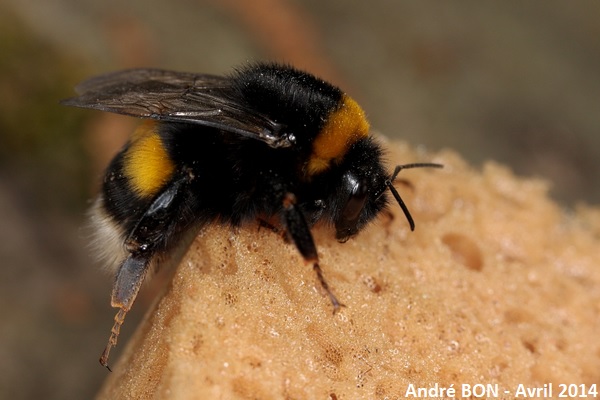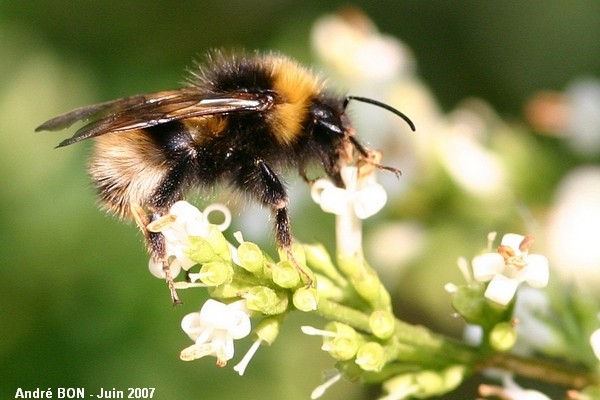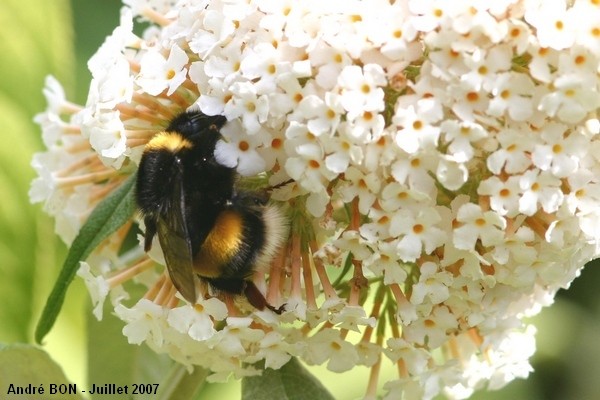


| White-tailed Bumblebee Complex (Bombus (Terrestribombus) sp. (Vogt, 1911)) |



|
|
Scientific name: Bombus (Terrestribombus) sp. (Vogt, 1911) Common name: White-tailed Bumblebee Complex Other names: The White-tailed Bumblebee Complex includes the following species that are very difficult to differentiate on pictures: The Buff-tailed Bumblebee (Bombus terrestris, Linnaeus, 1761), the White-tailed Bumblebee (Bombus lucorum, Linnaeus, 1758), the Northern White-tailed Bumblebee (Bombus magnus, Vogt, 1911) and the Cryptic Bumblebee (Bombus cryptarum, Fabricius, 1775). French name: Bombus du groupe terrestris Order: Hymenoptera Family: Apidae Wingspan : Respective body size of queens/workers/males (in mm); Bombus terrestris : 20-23/11-17/14-22; Bombus lucorum : 18-22/9-16/14-16; Bombus magnus : 22-28/8-18/14-18; Bombus cryptarum : 18-20/9-16/13-16. Biotope: Forests, flower meadows, heathlands, cultivated fields, parks and gardens. Up to an altitude of 2000 metres. Geographic area: Bombus terrestris : All Europe but missing in the extreme north. North Africa. South America. New Zealand. Bombus lucorum : Europe, including Iceland, north to the Barent sea but not reaching the Mediterranean sea in the south, temperate and northern Asia, east to Japan, western part of North America. Bombus magnus : Atlantic coast of western Europe, from Portugal to Norway, scarcer towards east, a few populations mentioned in southern Finland and near Moscow. Bombus cryptarum : Europe, missing in the Iberian Peninsula and in Italy, Asia east to Kamchatka and Japan, northern part of North America. Observation period : Only fertilized females overwinter. They emerge from their diapause in spring to found a new colony, often in an old rodent burrow. The colony begins by being populated by workers, their number can reach 600 insects for the Buff-tailed Bumblebee, a little less for the other species. Fertile females and males appear at late summer. The colony disappears in autumn, only the fertilized females will overwinter in diapause in a retreat. |
You can recognize the members of the White-tailed Bumblebee Complex with the broad orange yellow band ahead of the thorax and another similarly coloured band on the second segment of the abdomen. The abdomen's tip is covered with white hairs. Like Honey Bees, these Bumblebees feed on nectar they directly collect with their more or less long tongue. They also collect pollen by brushing their hairs. Queens and workers use pollen baskets located on the tibias of their hind legs to carry the pollen to the nest. Here are some elements about the differences between the species in the group. Bombus terrestris and Bombus magnus queens are a larger size. Bombus lucorum queens often show rather light coloured yellow bands. The one located ahead of the thorax is always rather broad. The tip of the abdomen is a pure white colour. Bombus terrestris queens may show a narrow yellow stripe ahead of the thorax and a off-white coloured abdomen tip. Bombus magnus queens resemble Bombus lucorum queens but the broad yellow band on the thorax extends on the lateral sides below the base of the wings and without any comma-shaped black marking. Bombus cryptarum queens bear a small S-shaped or comma-shaped black marking in the thoracic yellow band, just ahead of the wing base and separating the extension of the yellow band on the lateral sides of the thorax. You can recognize male Bombus lucorum with some yellow hairs on the face and clearly greyish hairs on the black part of the thorax. Male Bombus magnus and Bombus cryptarum also bear yellow hairs on the face. Their thorax is never greyish. They are difficult to separate. Male Bombus terrestris always show a pure black face. Only female Bumblebees can sting when provoked and ,unlike Honey Bees, they can withdraw their sting and they do not die. |
| [To know more about the White-tailed Bumblebee Complex] [Next picture] [Top] |

|
I have counted 12 articles (including scape and pedicel) on the antennae, so this one is a female (males have antennae with 13 articles). This is confirmed by the presence of pollen combs and brushes (males miss them). The observation date was maybe the first clue to take into account, males only appear in late summer. I should have measured the body size to know if this one is a queen or a worker. I think that it is possible that this one is Bombus terrestris, because of the rather dark orange colour of the thoracic band and because of the abdomen tip not being a pure white colour. |
| [To know more about the White-tailed Bumblebee Complex] [Next picture] [Previous picture] [Top] |

|
Looking again at this picture I am no longer sure to have here one member of the Terrestris complex. I am intrigued by the colour of the abdomen tip. |
| [To know more about the White-tailed Bumblebee Complex] [Previous picture] [Top] |

|
The Buddleia blossom makes a good stock of nectar. |